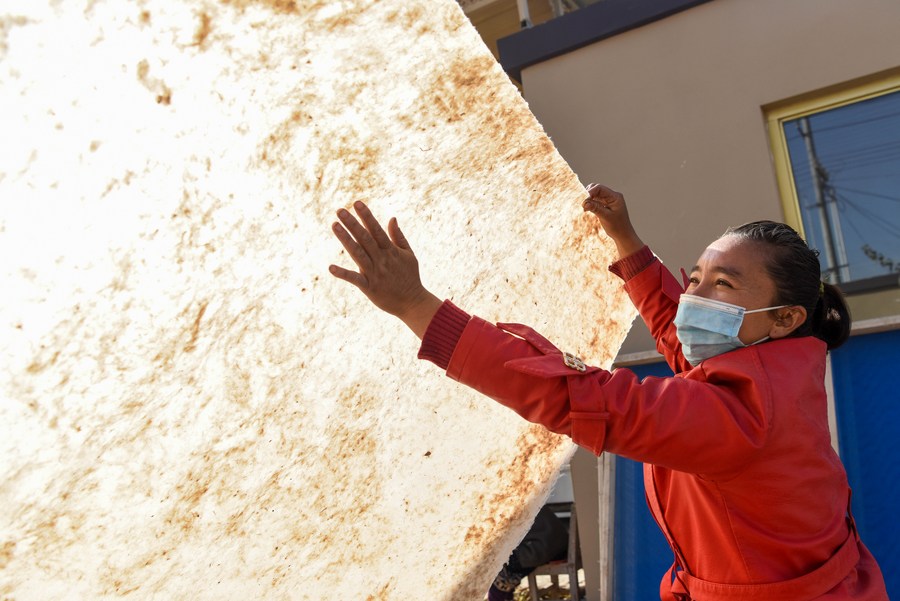Craftsman finds significance beyond making paper
Cheng Wei, an inheritor of bark paper-making skills in Jingxian county, Xuancheng city, east China’s Anhui Province, has rejected job opportunities in big cities and taken on the responsibility of inheriting the thousand-year-old handicraft for the last 11 years.
Born into a paper-making family, the difficulty involved in learning the skill is deeply engraved in Cheng’s mind. Manufacturing hand-made bark papers with passion and a positive attitude has always been Cheng’s working principle and objective.

A craftswoman checks a sheet of mulberry bark paper in Moyu County of Hotan, northwest China's Xinjiang Uygur Autonomous Region, Nov. 1, 2020. Mulberry bark paper-making, a craft with over 1,300 years of history, is listed as a Chinese national intangible cultural heritage. The paper boasts qualities of being antiseptic, absorbent and tensile. (Xinhua/Ding Lei)
Cheng's family was worried that their paper making skills would be lost to time. Seeing his ageing parents still working hard to make a living through paper making and to pass down the craft, Cheng started thinking about taking over their responsibilities from them.
In 2011, he left his job in Guangzhou, and returned home to take up paper-making.
Cheng started as an apprentice for his father, immersing himself in the minutiae of first-hand bark paper-making.
Making bark paper is difficult work. For hand-made bark paper, there are a dozen steps involved, from skinning the trees to the final materialization of the papers, which takes from one week to 40 days. It requires a year for the paper to be completed.
Collection of raw materials serves as a typical example. Workers must peel the bark from the roots to the branches. Cheng said that the best part of a tree is in the middle section, and requires workers to pinch the head and tail and remove the forked branches, a task so time-consuming that many workers are unwilling to do it.
The main raw materials come from the bark of paper mulberry trees and blue sandalwood trees. There is a paper mulberry wood right on the hill behind Cheng’s home, and a blue sandalwood wood is located in the remote mountains. Cheng likes to collect materials with his father, because they can talk about tree bark on the way.
After collecting raw materials, Cheng boils the bark with plant ash and limestone, which can increase the yield of thick liquid and eliminate pectins and lignins. This step guarantees the quality in the following production steps, and prevents papers from being polluted by impurities.
In a workshop, Cheng puts the battered bark into a pool and adds natural and pollution-free carambola vine juice to it. His family has contracted 5 mu (3,333.33 square meters) of carambola vine planting fields. When the fruits are ripe, tourists can come to pick them. This not only increases the raw materials for bark paper production, but also boosts the income of local growers.
Cheng has tried all possible raw materials to make paper. Sometimes, when he discovers plants he is not familiar with, he goes online to research them.
In his spare time, Cheng likes to read books about the paper cultures of China and other countries. After being inspired by the books, he tries to realize his new ideas, which is sometimes hard to accomplish immediately and usually requires months of effort. In 2018, after two years of hard work with his father, Cheng produced paper that was suitable for ancient book restoration. Featuring outstanding quality and high purity, the paper is widely used in historical book restorations.
Cheng always remembers what his father once said to him: “Don’t do what other people do, do your best in what other people are unwilling to do”. Influenced by his family, he is determined to focus on paper making skills, and believes that spending five or even 10 years on producing one kind of paper is worthwhile.
“This is my source of cultural confidence,” says Cheng.
Photos
Related Stories
Copyright © 2023 People's Daily Online. All Rights Reserved.









